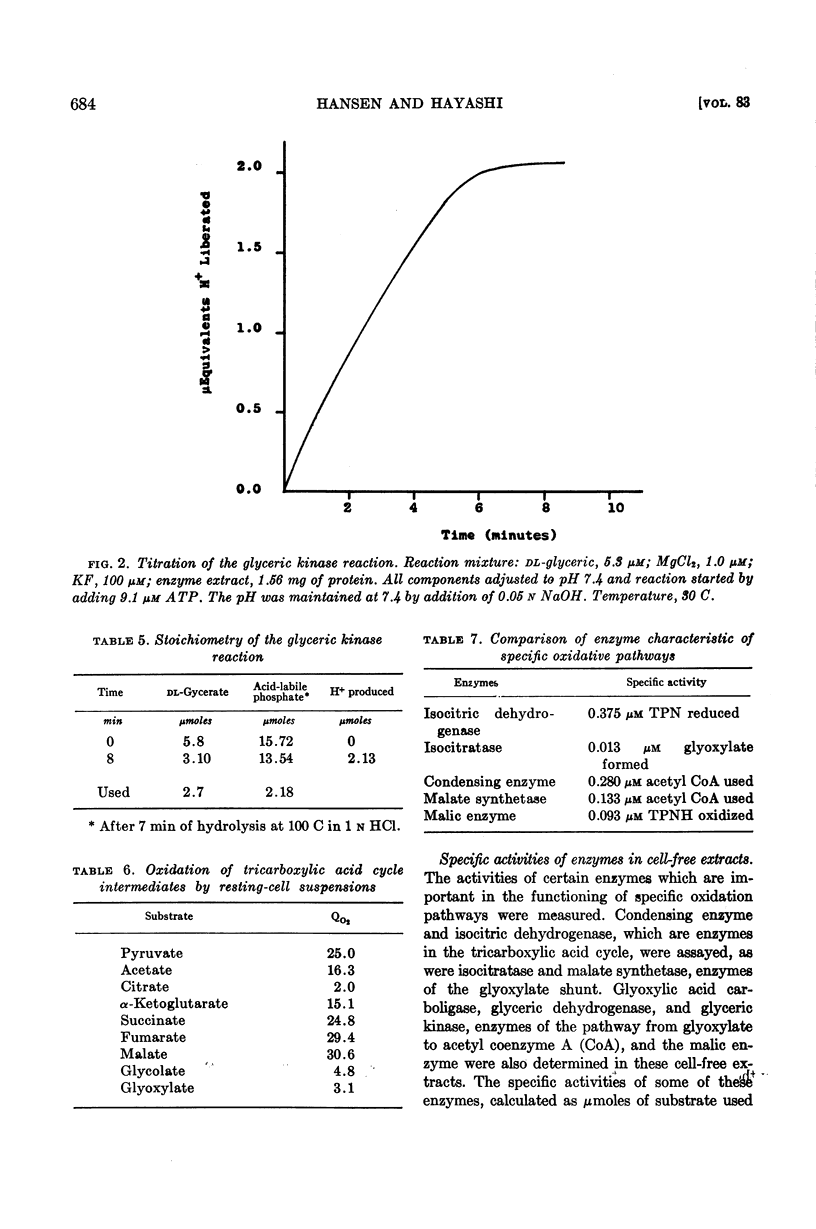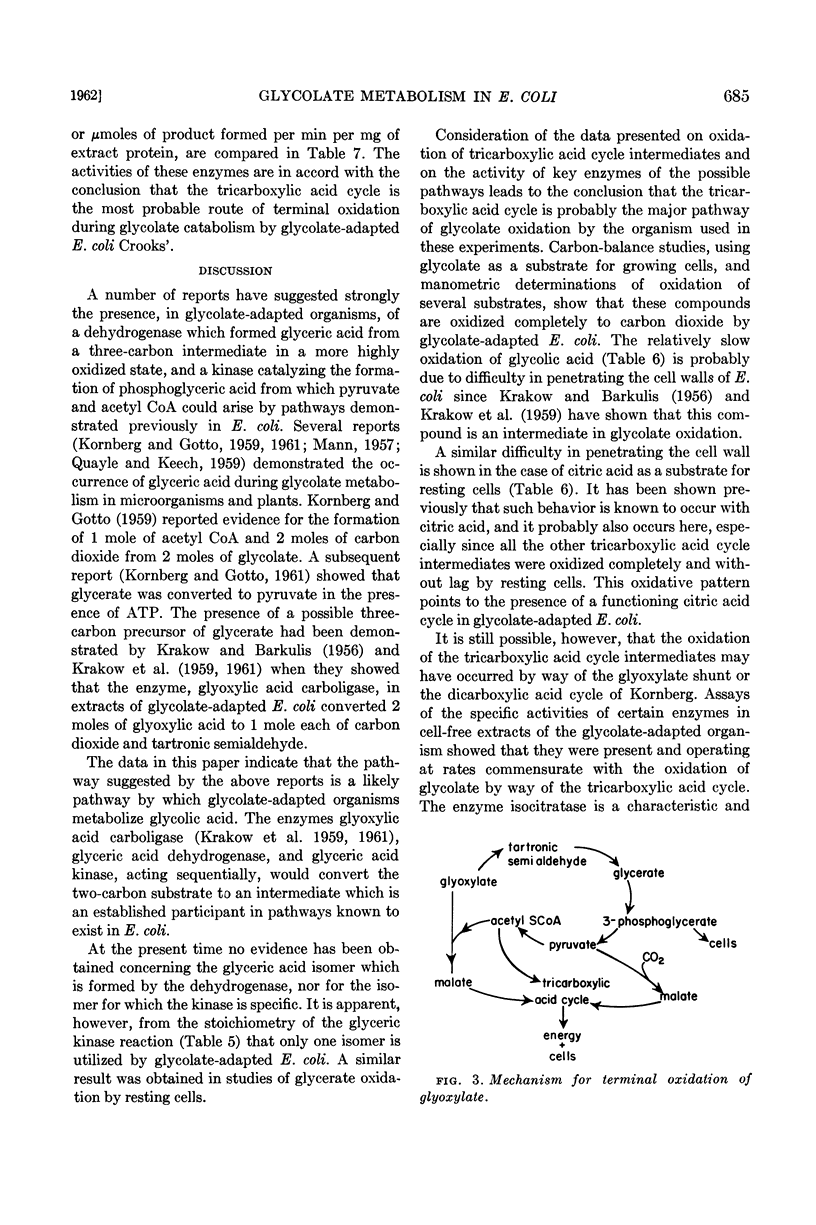Abstract
Hansen, Robert W. (University of Illinois College of Medicine, Chicago) and James A. Hayashi. Glycolate metabolism in Escherichia coli. J. Bacteriol. 83:679–687. 1962.—This study of glycolate-adapted Escherichia coli indicates that the most probable route for utilization of the substrate includes glyceric acid, 3-phosphoglyceric acid, and the tricarboxylic acid cycle. A glyceric acid dehydrogenase, which reduces tartronic semialdehyde to glycerate in the presence of reduced diphosphopyridine nucleotide, and a kinase, which catalyzes the formation of 3-phosphoglycerate from glyceric acid and adenosine triphosphate, were shown to be present. Carbon recoveries in growing cultures and manometric data obtained with resting cells showed the complete oxidation of glycolate to carbon dioxide. Measurements of the oxidation of tricarboxylic acid cycle intermediates indicated that these compounds are oxidized without lag and at a rate commensurate with the rate of glycolate oxidation. Assays of the enzymes characteristic of known pathways of terminal oxidation, such as isocitratase, malate synthetase, isocitric dehydrogenase, and condensing enzyme, provided further evidence for an operating tricarboxylic acid cycle. A postulated pathway for the utilization of glycolic acid is as follows: glycolate → glycerate → 3-phosphoglycerate → pyruvate → tricarboxylic acid cycle.
Full text
PDF








Selected References
These references are in PubMed. This may not be the complete list of references from this article.
- AJL S. J., RUST J., Jr, WHEAT R. W. Distribution of the tricarboxylic acid cycle enzymes in extracts of Escherichia coli. J Cell Physiol. 1956 Jun;47(3):317–339. doi: 10.1002/jcp.1030470303. [DOI] [PubMed] [Google Scholar]
- BACHRACH U. The degradation of glycine by Pseudomonas aeruginosa. Biochem J. 1957 Aug;66(4):559–561. doi: 10.1042/bj0660559. [DOI] [PMC free article] [PubMed] [Google Scholar]
- BANDURSKI R. S., AXELROD B. The chromatographic identification of some biologically important phosphate esters. J Biol Chem. 1951 Nov;193(1):405–410. [PubMed] [Google Scholar]
- BARKULIS S. S., KRAKOW G. Conversion of glyoxylate to hydroxypyruvate by extracts of Escherichia coli. Biochim Biophys Acta. 1956 Sep;21(3):593–594. doi: 10.1016/0006-3002(56)90208-6. [DOI] [PubMed] [Google Scholar]
- BARTLETT G. R. Colorimetric assay methods for free and phosphorylated glyceric acids. J Biol Chem. 1959 Mar;234(3):469–471. [PubMed] [Google Scholar]
- BLACK S., WRIGHT N. G. Enzymatic formation of glyceryl and phosphoglyceryl methylthiol esters. J Biol Chem. 1956 Jul;221(1):171–180. [PubMed] [Google Scholar]
- FRISELL W. R., MEECH L. A., MACKENZIE C. G. A simplified photometric analysis for serine and formaldehyde. J Biol Chem. 1954 Apr;207(2):709–716. [PubMed] [Google Scholar]
- ICHIHARA A., GREENBERG D. M. Studies on the purification and properties of D-glyceric acid kinase of liver. J Biol Chem. 1957 Apr;225(2):949–958. [PubMed] [Google Scholar]
- KORNBERG H. L., GOTTO A. M. Formation of malate from glycollate by Pseudomonas ovalis Chester. Nature. 1959 Jun 27;183:1791–1793. doi: 10.1038/1831791a0. [DOI] [PubMed] [Google Scholar]
- KORNBERG H. L., GOTTO A. M. The metabolism of C2 compounds in micro-organisms. 6. Synthesis of cell constituents from glycollate by Pseudomonas sp. Biochem J. 1961 Jan;78:69–82. doi: 10.1042/bj0780069. [DOI] [PMC free article] [PubMed] [Google Scholar]
- KORNBERG H. L., MADSEN N. B. The metabolism of C2 compounds in microorganisms. 3. Synthesis of malate from acetate via the glyoxylate cycle. Biochem J. 1958 Mar;68(3):549–557. doi: 10.1042/bj0680549. [DOI] [PMC free article] [PubMed] [Google Scholar]
- KORNBERG H. L., SADLER J. R. Microbial oxidation of glycollate via a dicarboxylic acid cycle. Nature. 1960 Jan 16;185:153–155. doi: 10.1038/185153a0. [DOI] [PubMed] [Google Scholar]
- KRAKOW G., BARKULIS S. S., HAYASHI J. A. Glyoxylic acid carboligase: an enzyme present in glycolate-grown Escherichia coli. J Bacteriol. 1961 Apr;81:509–518. doi: 10.1128/jb.81.4.509-518.1961. [DOI] [PMC free article] [PubMed] [Google Scholar]
- QUAYLE J. R., KEECH D. B. Formation of glycerate from oxalate by Pseudomonas oxalacticus (OXI) grown in oxalate. Nature. 1959 Jun 27;183:1794–1795. doi: 10.1038/1831794a0. [DOI] [PubMed] [Google Scholar]
- STAFFORD H. A., MAGALDI A., VENNESLAND B. The enzymatic reduction of hydroxypyruvic acid to D-glyceric acid in higher plants. J Biol Chem. 1954 Apr;207(2):621–629. [PubMed] [Google Scholar]
- SWIM H. E., KRAMPITZ L. O. Acetic acid oxidation by Escherichia coli; evidence for the occurrence of a tricarboxylic acid cycle. J Bacteriol. 1954 Apr;67(4):419–425. doi: 10.1128/jb.67.4.419-425.1954. [DOI] [PMC free article] [PubMed] [Google Scholar]


